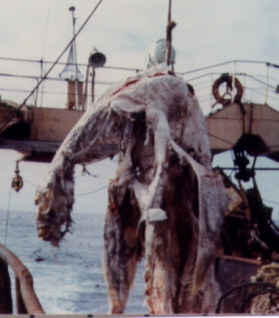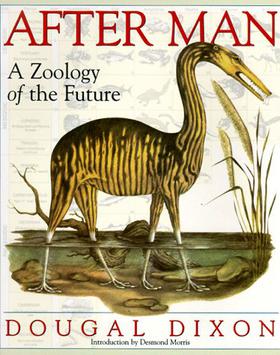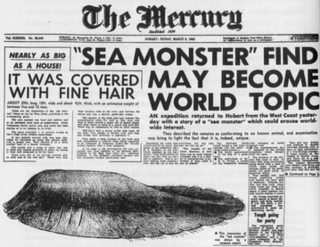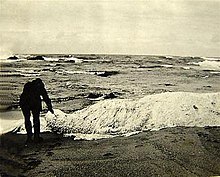
Bigfoot, also commonly referred to as Sasquatch, is a large and hairy human-like mythical creature purported to inhabit forests in North America, particularly in the Pacific Northwest.

The Loch Ness Monster, affectionately known as Nessie, is a creature in Scottish folklore that is said to inhabit Loch Ness in the Scottish Highlands. It is often described as large, long-necked, and with one or more humps protruding from the water. Popular interest and belief in the creature has varied since it was brought to worldwide attention in 1933. Evidence of its existence is anecdotal with a number of disputed photographs and sonar readings.

Mokele-mbembe, Lingala for "one who stops the flow of rivers", is a water-dwelling entity that supposedly lives in the Congo River Basin, sometimes described as a living creature, sometimes as a spirit. Descriptions vary widely among those who claim to have seen the creature, but it is often described as a large quadrupedal herbivore with smooth skin, a long neck and a single tooth or horn.

Marine mammals are aquatic mammals that rely on the ocean and other marine ecosystems for their existence. They include animals such as seals, whales, manatees, sea otters and polar bears. They are an informal group, unified only by their reliance on marine environments for feeding and survival.

Sea monsters are beings from folklore believed to dwell in the sea and often imagined to be of immense size. Marine monsters can take many forms, including sea dragons, sea serpents, or tentacled beasts. They can be slimy and scaly and are often pictured threatening ships or spouting jets of water. The definition of a "monster" is subjective; further, some sea monsters may have been based on scientifically accepted creatures, such as whales and types of giant and colossal squid.
Cadborosaurus, nicknamed Caddy by journalist Archie Wills, is a sea serpent in the folklore of regions of the Pacific Coast of North America. Its name is derived from Cadboro Bay in Greater Victoria, British Columbia, and the Greek root word "saurus" meaning lizard or reptile.

There have been several cases of exploding whale carcasses due to a buildup of gas in the decomposition process. This would occur if a whale stranded itself ashore. Actual explosives have also been used to assist in disposing of whale carcasses, ordinarily after towing the carcass out to sea, and as part of a beach cleaning effort. It was reported as early as 1928, when an attempt to preserve a carcass failed due to faulty chemical usages.

A globster or blob is an unidentified organic mass that washes up on the shoreline of an ocean or other body of water. A globster is distinguished from a normal beached carcass by being hard to identify, at least by initial untrained observers, and by creating controversy as to its identity.

The Zuiyo-maru carcass was a corpse, most likely a basking shark, caught by the Japanese fishing trawler Zuiyō Maru (瑞洋丸) off the coast of New Zealand in 1977. The carcass's peculiar appearance led to speculation that it might be the remains of a sea serpent or prehistoric plesiosaur.

After Man: A Zoology of the Future is a 1981 speculative evolution book written by Scottish geologist and palaeontologist Dougal Dixon and illustrated by several illustrators including Diz Wallis, John Butler, Brian McIntyre, Philip Hood, Roy Woodard and Gary Marsh. The book features a foreword by Desmond Morris. After Man explores a hypothetical future set 50 million years after extinction of humanity, a time period Dixon dubs the "Posthomic", which is inhabited by animals that have evolved from survivors of a mass extinction succeeding our own time.
In Canadian folklore, the Manipogo is a lake monster said to live in Lake Manitoba, Manitoba, Canada. The creature was dubbed Manipogo in 1960, the name echoing British Columbia's Ogopogo. There is also a Lake Winnipegosis monster called Winnepogo, thought possibly to be the same creature since the lakes are connected. It is the namesake of the Manipogo Provincial Park.

Darren William Naish is a British vertebrate palaeontologist, author and science communicator.

The St. Augustine Monster is the name given to a large carcass, originally postulated to be the remains of a gigantic octopus, that washed ashore on the United States coast near St. Augustine, Florida in 1896. It is sometimes referred to as the Florida Monster or the St. Augustine Giant Octopus and is one of the earliest recorded examples of a globster. The species that the carcass supposedly represented has been assigned the binomial names Octopus giganteus and Otoctopus giganteus, although these are not valid under the rules of the ICZN.

The Tasmanian Globster was a large unidentified carcass that washed ashore 2 miles north of Interview River in western Tasmania, in August 1960. It measured 20 ft (6.1 m) by 18 ft (5.5 m) and was estimated to weigh between 5 and 10 tons. The mass lacked eyes and in place of a mouth, had "soft, tusk-like protuberances". It had a spine, six soft, fleshy 'arms' and stiff, white bristles covering its body.
A whale carcass, initially unidentified due to decomposition, was found washed ashore at Muriwai Beach, 42 kilometres from the centre of Auckland in New Zealand, in March 1965. At some point in time it was dubbed a "globster", after the Tasmanian Globster, a whale carcass found in Australia a few years earlier.

Bermuda Blob is the name given to two globsters that washed ashore on Bermuda in 1988 and 1997. Originally thought to be the remains of a cryptid, analysis proved the blobs to be the remains of whales.

Tecolutla is a town and municipality located on the Tecolutla River on the eastern coast of the state of Veracruz in Mexico. It has the closest beaches to Mexico City, and much of its economy is based on tourism, as it is only a four- or five-hour drive from the capital. It is the northern end of a tourist corridor along the Gulf of Mexico called the "Emerald Coast," which extends down to the city of Veracruz.

The "Panama Creature" refers to a carcass photographed near the town of Cerro Azul, Panama, in September 2009. After the animal was discovered and reputedly killed by a group of teenagers, photographs of the corpse were given to Telemetro, a Panamanian television station. The story and pictures circulated, and comparisons to the Montauk Monster were made. There was speculation about the identity of the creature, with suggestions including a hairless sloth, an alien species and a creature new to science. A biopsy performed by the National Environmental Authority of Panama on the remains a few days after the creature's discovery concluded that the corpse was in fact that of a male brown-throated sloth. The odd appearance had been caused by underwater decomposition, which had resulted in hair loss. Once identified, the corpse was buried.
Cryptid whales are cetaceans claimed to exist by cryptozoologists on the basis of informal sightings, but not accepted by taxonomists as they lack formal descriptions of type specimens. Over the past few hundred years, sailors and whalers have reported seeing whales they cannot identify. The most well-known are Giglioli's Whale, the rhinoceros dolphin, Trunko, the high-finned sperm whale, and the Alula whale.














